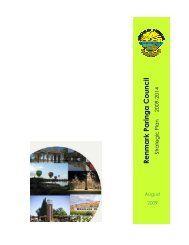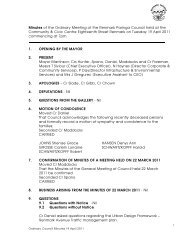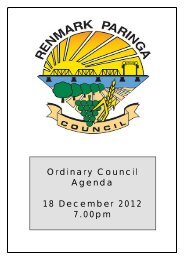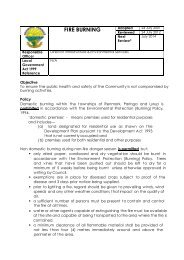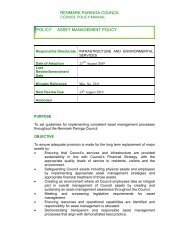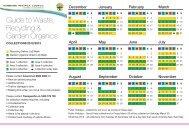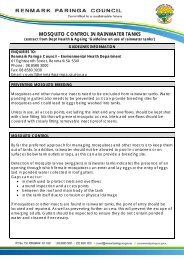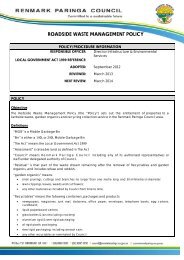preliminary site investigation report - Renmark Paringa Council - SA ...
preliminary site investigation report - Renmark Paringa Council - SA ...
preliminary site investigation report - Renmark Paringa Council - SA ...
You also want an ePaper? Increase the reach of your titles
YUMPU automatically turns print PDFs into web optimized ePapers that Google loves.
Riverland Futures TaskforceAWEAppendicesAppendix A : <strong>Council</strong>s Development Plan Zoning InformationAppendix B : Aerial PhotographsAppendix C : EPA Section 7 ReportsAppendix D : PIR<strong>SA</strong> Research Centre Layout PlanAppendix E : Site Inspection PhotographsAppendix F : Dial Before You Dig Responses10184, Riverland Better Development Conversion and Alignment DPA's v
Riverland Futures TaskforceAWE1 Introduction1.1 BackgroundAustralian Water Environments was engaged by the Riverland Futures Taskforce to prepare aPreliminary Site Investigation Report, in the form of a Site History Assessment, which included severallocations throughout the Riverland. These locations include properties in Loxton, Waikerie, Berri,<strong>Renmark</strong> and <strong>Paringa</strong>. Location plans are provided in Figures 1, 2, 3, 4 and 5.In association with the three Riverland <strong>Council</strong>’s (Loxton/Waikerie, Berri/Barmera and <strong>Renmark</strong>/<strong>Paringa</strong>)and the Department of Planning and Local Government, the Riverland Futures Taskforce is undertakingthe Riverland Development Plan Conversion and Alignment DPA’s. The DPA’s will include:The Better Development ConversionPromotion of alignment and consistent policyPromotion of economic developmentVarious local amendments to cater for growth.As part of the DPA process, the project partners propose to rezone various parcels of land fromHorticulture or Dryland Farming to Rural Living and an area at Berri, from Public Purpose to Residential.The EPA, as part of their legislative requirements, requires the project partners to determine if apotentially contaminating land use has occurred on the land and/or if further assessment of <strong>site</strong>contamination is necessary. The EPA requested this to be presented in the form of a Preliminary SiteInvestigation Report.The objectives of the <strong>site</strong> information was to identify potential source(s) of contamination associatedwith current or historical <strong>site</strong> use that may impact on the suitability of the <strong>site</strong> for redevelopment, orwarrant further <strong>investigation</strong>/assessment. Due to the sizes of the <strong>site</strong>s this <strong>investigation</strong> has aimed toidentify <strong>site</strong> wide potential contamination pathways, however where possible <strong>site</strong> specific potentialcontamination issues have been highlighted.1.2 Project InceptionA project inception meeting was undertaken on 4 June 2010 at the AWE office. Generally, the meetingconfirmed the scope of works outlined in the proposal dated 21 May 2010. One change identified duringthe meeting was for the future rural living <strong>site</strong> in south east Waikerie. This <strong>site</strong> was not to be included inthe <strong>investigation</strong>, however an area of land directly north and adjoining this <strong>site</strong> was to be investigated.The new <strong>site</strong> is identified in the brief figures as “existing country living (to be rezoned accordingly)” andhas been referred to in this <strong>report</strong> as Waikerie East.Follow up communications identified significant individual allotments within the identified <strong>site</strong>s for<strong>investigation</strong> and therefore information requests (certificates of title (CT), current and/or historical aerialphotography, GIS and current zoning information etc.) from each participating council was undertaken.Due to the significant numbers of individual CT’s the program and feedback was staged to allow<strong>preliminary</strong> comment of historical CT ownership and was undertaken in the following sequence: Loxtonand Waikerie, Berri and <strong>Renmark</strong> and <strong>Paringa</strong>.1.3 Scope of WorkThe scope of work for the <strong>investigation</strong> was undertaken in accordance with Schedule B(2) – Guidelineson Date Collection, Sample Design and Reporting outlines in the National Environmental Protection(Assessment of Site Contamination) Measure (NEPC, 1999) with the following activities undertaken aspart of the <strong>investigation</strong>.10184, Riverland Better Development Conversion and Alignment DPA's 1
AWERiverland Futures TaskforceReview of current and previous certificates of title to assess ownership and possible formeruses of the <strong>site</strong>;Review of historical maps, surveys and building plans of the <strong>site</strong>;A search of the EPA records held relevant to Section 7 – Land and Business (Sale andConveyancing Act) 1994;Review of geological and hydrogeological information pertaining to the <strong>site</strong> including geologicalmaps and bore search data;Review of current and historical uses of the <strong>site</strong> through inspection of historical aerialphotographs;Identification of any potential <strong>site</strong> and adjacent activities that may have had a negative impacton <strong>site</strong> soils and/or groundwater;Site inspection to confirm current <strong>site</strong> layout;Discussion with previous <strong>site</strong> owner(s) and/or employees for relevant <strong>site</strong> history; andProduction of a <strong>report</strong> detailing the findings of the Phase 1 Environmental Site Assessment andproviding detailed recommendations for any Phase 2 Investigation requirements.Additional to the <strong>site</strong> history <strong>investigation</strong> it was requested that comments be made for the suitability ofeither on-<strong>site</strong> effluent disposal or connection to the community wastewater management system’s(CWMS) infrastructure for each <strong>site</strong> in Loxton, Waikerie, <strong>Renmark</strong> and <strong>Paringa</strong>. Berri does not requireany effluent disposal assessment as connection to the CWMS is preferred.2 10184, Riverland Better Development Conversion and Alignment DPA's
Riverland Futures TaskforceAWE2 LoxtonTwo sections of land comprising many existing individual parcels are proposed for <strong>investigation</strong> and areidentified in Figure 1 as Loxton North East and Loxton East.<strong>Council</strong> has also requested comments for the suitability for either on-<strong>site</strong> effluent disposal or connectionto CWMS.2.1 Regional Setting2.1.1 TopographyThe Department of Environment and Heritage five (5) metre Topographic Contours covering Loxtonindicates:2.1.2 GeologyLoxton North East lies between approximately 34m and 43m above Australian Height Datum(AHD). The area is generally undulating, where the North-eastern (~34m AHD), North-western(~39m AHD), and South-western (~39m AHD) boundaries present lower elevations than centralsections (~42m AHD), and Northern (~43m AHD) and South-eastern (~42m AHD) boundaries;Loxton East lies between approximately 37m and 45m AHD. The local topography is undulated,demonstrating top elevations at the south-eastern corner (~45m AHD) and central-westernsection (~45m AHD) and low lying sections at western corners and central-eastern boundary;andRiver Murray water levels lies slightly above 10m AHD at Loxton.The following detailed description of geology for the Loxton region is informed by the analysis <strong>report</strong>conducted by AWE for the Bookpurnong and Loxton Approval Submissions (AWE 2003).Generally the highlands of the River Murray are covered by Quaternary Woorinen Formation sediments.The Quaternary sediments are underlain by Tertiary sediments of Blanchetown Clay (thoughdiscontinuous and sometimes absent), Loxton Sands, Murray Group and <strong>Renmark</strong> Group sediments.2.1.3 HydrogeologyThe Upper Loxton Sands are generally unsaturated, however in the Loxton Irrigation district a perchedwater table can be found which saturates the Upper Loxton Sand. This is likely a direct result ofpercolation of irrigation water past the root zone. Irrigation water drains through the Woorinen Sandsand Blanchetown Clay (where present) before it reaches the Upper Loxton Sands. There can besignificant variation of salinity within the Loxton sands and the presence of these perched aquifersinfluences local recharge processes.The water table lies within the Murray Group sediments which are comprised of many differentformations (Pata, Winambool, Glenforslan, Finniss and Upper Mannum Formations) with the PataFormation a regionally targeted salt interception scheme aquifer.2.2 Site Identification2.2.1 Site Details and ZoningAll properties of the Loxton North East and Loxton East <strong>investigation</strong> areas are within the LoxtonHundreds of Gordon and Bookpurnong respectively.10184, Riverland Better Development Conversion and Alignment DPA's 3
AWERiverland Futures TaskforceAREA OF INVESTIGATION SITESLoxton North East approximately 44 ha;Loxton East approximately 64 ha.LOCAL GOVT. AUTHORITYDistrict <strong>Council</strong> of Loxton WaikerieZONINGHorticulture (Refer to Appendix A formore detail on zoning)SITE U<strong>SA</strong>GELoxton North East is dominated by existing horticulture andassociated buildings (shedding, packaging and storage);Loxton East current <strong>site</strong> usage includes small scale horticulture,some dwellings and either vacant (suspect cleared) orcrop/grazing properties.Refer Table 2-1 for individual allotment ownership, however copies of individual CTs have not beensupplied by the council.2.3 Current Land Use and Setting2.3.1 Loxton North EastThe Loxton North East <strong>site</strong> is located approximately 1.3 km north of the Loxton East area and isbounded by the Loxton High School, Bookpurnong Road, Dorsch Avenue and Gratwick Road. This <strong>site</strong>is generally covered with horticulture and associated buildings.2.3.2 Loxton EastAt the closest point the Loxton East <strong>site</strong> is located approximately 1.6km south east of the Murray River.The area is bounded by:A number of allotments on Robertson Avenue to the west;Baker Street and Mackey Road to the south; andBadcoe Road along the eastern and northern boundaries.Currently the <strong>site</strong> has existing small scale horticulture with several dwellings and sheds.2.4 Proposed DevelopmentThe proposed rezoning of the land is for 2,000 – 4,000 m 2 rural living allotments.2.5 Historical Review2.5.1 OwnershipDue to the number of CT’s, information was gathered direct from Lands Title Office (LTO) electronicinformation and state records microfiche and therefore copies have not been included. Detailedhistorical ownership is presented in Table 2-2.4 10184, Riverland Better Development Conversion and Alignment DPA's
Riverland Futures TaskforceAWE2.5.2 Aerial Photograph ReviewA review of historical aerial photographs provided by the Department of Environment & Heritage(Mapland) from 1956, 1976, 1984, 1996 and 2008, was undertaken. The observations from the aerialphotograph review are presented in Table 2-3, with selected aerial photographs provided inAppendix B.2.5.3 EPA Section 7 RecordsA search of the EPA records held relevant to section 7 – Land and Business (Sale and Conveyancing Act)1994 is usually undertaken as part of a <strong>site</strong> history. EPA section 7 records were reviewed for informationin regard to the following:Environmental performance agreements, protection orders, clean-up orders or clean-upauthorisations issued for the <strong>site</strong>;Environmental assessment <strong>report</strong>s held by the EPA that have been prepared by or on behalf ofan owner or occupier of the land, by the EPA, or by a Contaminated Site Auditor;Whether the <strong>site</strong> is/was licensed by the EPA to operate as a waste depot;Whether the <strong>site</strong> is/was issued with a licence by the EPA to produce waste of a prescribed kindor to carry out an activity that produces a listed waste on the land;Records on the Public Register of waste being depo<strong>site</strong>d on the land;Records and details on Pollution and <strong>site</strong> contamination on the land.No evidence of any of these activities occurring at the <strong>site</strong> was recorded. Copies of the EPA Section 7records are contained in Appendix C.This search did not identify any areas of significance within the <strong>site</strong> area.2.5.4 Site InspectionA <strong>site</strong> inspection was undertaken on 28 July 2010 to confirm or otherwise current <strong>site</strong> layout. Generallythe <strong>site</strong>s were being utilised for horticulture with scattered residential premises. Specific inspection ofthe PIR<strong>SA</strong> Research Centre (CT 5959/742) in Loxton North East was undertaken to identify additionalpotential contamination sources.During the <strong>site</strong> inspection the following was noted:Loxton North EastLoxton EastTile drainage system running east west through the centre of the <strong>site</strong>;Site dominated by vines and citrus;Large section of citrus recently removed;The PIR<strong>SA</strong> Research Centre no longer stores any chemicals on-<strong>site</strong> (stored on property on theother side of the road) and have only recently had poly (glass) houses installed which are beingused to grow vegetables and tobacco. AWE was supplied a <strong>site</strong> layout plan which is provided inAppendix D.Tile drainage system evident on the low lying southern and south west corner of the <strong>site</strong>;Site dominated by vines and citrus;Large sections of citrus and vines recently removed; andSeveral original workers dormitories still exist.Selections of <strong>site</strong> inspection photographs are provided in Appendix E.10184, Riverland Better Development Conversion and Alignment DPA's 5
AWERiverland Futures Taskforce2.5.5 <strong>Council</strong> RecordsNo additional council records were provided by the Loxton Waikerie council for review with theexception of some small scale aerial figures.2.5.6 Dial Before You DigPreliminary Dial Before You Dig (DBYD) web searches were undertaken. Underground services trenchesare potential pathways for contamination pathways into or off-<strong>site</strong>. Discussions with the various serviceproviders generally <strong>report</strong>ed limited services which predominantly follow constructed roads.DBYD responses are provided in Appendix F.2.6 Potential Contamination Issues2.6.1 On Site SourcesBased on a review of historical information obtained for the <strong>site</strong>s, an assessment of the potential for soiland/or groundwater contamination to have occurred on the <strong>site</strong>s has been undertaken, with potentialissues identified and summarised in Tables 2-4 and 2-5.2.6.2 Off-Site SourcesAn allotment on the northern boundary of the Loxton East <strong>site</strong> which is used for stockpiling council fillhas been identified as a potential off-<strong>site</strong> contaminating land use.Land uses surrounding the remainder of the <strong>site</strong> present little potential risks to human health and/orenvironment for the study <strong>site</strong>.2.7 Effluent DisposalOn-<strong>site</strong> effluent disposal may be suitable for the Loxton North East <strong>site</strong> due to expected depth togroundwater (~20m bgl) and meeting the <strong>SA</strong> Health On-<strong>site</strong> Wastewater Systems Codes, 2009 (<strong>SA</strong>Health, 2009) minimum distance “Disposal of effluent is not permitted within the 1956 River Murray andlakes flood zone with a setback of at least 100 metres and above the 1956 level”. However, connectionto the CWMS infrastructure should remain an option as a drainage network, identified during the <strong>site</strong>inspection, indicates that near surface perched groundwater is likely. As no drainage bores wereidentified within the Loxton North East <strong>site</strong> on the Department of Primary Industries and Resources ofSouth Australia (PIR<strong>SA</strong>) Drillhole Enquiry System (DES) web<strong>site</strong>, this will require further <strong>investigation</strong>.On-<strong>site</strong> effluent disposal may also be suitable for the Loxton East <strong>site</strong>, however connection to the CWMSinfrastructure should remain an option as several drainage bores (7029-593, 7029-594, 7029-595 and7029-596) are located within the <strong>site</strong>. Although drainage bores 7029-594, 7029-595 and 7029-596 <strong>report</strong>groundwater levels greater than 20m bgl the presence of these drainage bores indicates potential nearsurface perched groundwater. Additionally, the presence of these bores presents additional minimumsetback distance requirements.2.8 ConclusionsDue to the sizes of the <strong>site</strong>s with many individual allotments and based on a review of the <strong>site</strong>’s historyand a review of surrounding land uses a general assessment of the potential for contamination of the<strong>site</strong>s were undertaken for both the Loxton North East and Loxton East <strong>site</strong>s.Horticulture still dominates both <strong>site</strong>s and with the earliest (1956) aerial photograph showing both <strong>site</strong>swere already being utilised by either horticultural of agricultural purposes with only been minor changesover the last 30 to 40 years.The Site History Assessment (SHA) has identified the following potentially contaminating activities:6 10184, Riverland Better Development Conversion and Alignment DPA's
Riverland Futures TaskforceAWEPesticide and/or herbicide and fertilizer use;Dwellings, shedding and storage (under floor treatment, under slab fill and lay down areas,potential temporary storage of fuel (ASTs), oil and pesticides/herbicides);Heavy vehicle and private vehicles storage and use (tractors/cartage trucks, utes/vans etc.); andLocalised point source dumping (rubbish, waste and various horticultural products including:equipment, metals, plastic containers, posts, irrigation pipe etc.).Given the SHA has been undertaken for the purposes of rezoning to Rural Living as part of theDevelopment plan conversion process, the following would be recommended to be undertaken at thedevelopment assessment stage and suitable policies be contained within the Development Plan inrelation to future <strong>site</strong> assessment:Site wide sampling according to AS 4482.1-2005 (“A Guide to the Sampling and Investigation ofPotentially Contaminated Soil”) with targeted sampling beneath storage sheds, dumpinglocations and lay down areas.Baseline groundwater analysis due to the presence of the drainage systems. However,discussions with EPA would determine groundwater assessment as beneficial groundwater useswould be limited due to the expected high TDS.Due to the <strong>preliminary</strong> nature of this <strong>investigation</strong> no soil and/or groundwater samples were collectedfor this <strong>investigation</strong>.10184, Riverland Better Development Conversion and Alignment DPA's 7
AWERiverland Futures Taskforce3 WaikerieTwo sections of land comprising many existing individual parcels are proposed for <strong>investigation</strong> and areidentified in Figure 2 as Waikerie West and Waikerie East.<strong>Council</strong> has also requested comments for the suitability for either on-<strong>site</strong> effluent disposal or connectionto CWMS.3.1 Regional Setting3.1.1 TopographyThe Department of Environment and Heritage five (5) metre Topographic Contours covering Waikerieindicates:3.1.2 GeologyWaikerie West lies between approximately 35m and 51m AHD. The local topography slopesgenerally from east to west;Waikerie South East is approximately 42m AHD. The local topography is undulated, with toplevels at the northern section; andRiver Murray water level lies between 5 and 10m AHD at Waikerie.The following detailed description of hydrogeology for the Waikerie region is informed by the datareview conducted by AWE for the Morgan to Lock 3 accredited groundwater model (AWE 2007), as wellas by recent observation and production bore drilling conducted by AWE (AWE 2009).Generally the highlands of the River Murray are covered by Quaternary/Tertiary sediments ofBlanchetown Clay, however at some locations a thin surface Quaternary layer of Woorinen Sand can bepresent. The Blanchetown Clay is underlain by Loxton Sands, Murray Group and <strong>Renmark</strong> Groupsediments.3.1.3 HydrogeologyThe Upper Loxton Sands are generally unsaturated in this region of the Murray Basin, however, aperched water table can be found in the Upper Loxton Sands, usually underlying older irrigationdevelopments or in localised depressions. This is likely a direct result of percolation of irrigation waterpast the root zone. Irrigation water drains through the Woorinen Sands (where present) andBlanchetown Clay (both unsaturated units) before it reaches the Upper Loxton Sands. The presence ofthese perched aquifers influences local recharge processes.The water table lies within the Murray Group sediments which are comprised of many differentformations (Bryant Creek, Cadell, Finniss, Upper and Lower Mannum and Ettrick Formations) with theLower Mannum Formation a regionally targeted salt interception scheme aquifer. Underlying the LowerMannum Formation is the Ettrick Formation aquitard, which separates the upper aquifer systems fromthe <strong>Renmark</strong> aquifer system below.3.2 Site Identification3.2.1 Site Details and ZoningAll properties of the Waikerie West and Waikerie East <strong>investigation</strong> areas are within the Hundreds ofWaikerie and Holder respectively.8 10184, Riverland Better Development Conversion and Alignment DPA's
Riverland Futures TaskforceAWEAREA OF INVESTIGATION SITESWaikerie West approximately 23 ha;Waikerie East approximately 106 ha.LOCAL GOVT. AUTHORITYDistrict <strong>Council</strong> of Loxton WaikerieZONINGHorticulture (Refer to Appendix A for more detail on zoning)SITE U<strong>SA</strong>GEWaikerie West is dominated by existing horticulture and scatteredfarmhouses and shedding;Waikerie East is also dominated by existing horticulture andassociated buildings. Housing appears more prevalent suggestingsmall scale ‘farmlet’ activities and also includes some smallbusinesses. Some native vegetation and vacant crop/grazing landapparent south of Ohlmeyer Road.Refer Table 3-1 for individual allotment ownership, however copies of individual CTs have not beensupplied by the council.3.3 Current Land Use and Setting3.3.1 Waikerie WestThe Waikerie West <strong>site</strong> is located adjacent the Waikerie High School, approximately 700m south west ofthe Waikerie Hospital and a further 500m from the River Murray. The area is bounded by:Blake Road along a section of the northern boundary,Sturt Highway along the eastern boundary; andExisting horticultural blocks along the remaining southern, western and northern boundaries.This <strong>site</strong> is generally covered with horticulture with limited dwellings and shedding.3.3.2 Waikerie EastAt the closest point the Waikerie East <strong>site</strong> is located approximately 150 m south of the Murray River. Thearea is bounded by:Railway Terrace and Checker and Curtis Roads to the west;Sturt Highway to the north;Searle Road along the east; andvacant and native scrub along the southern boundary.Currently the <strong>site</strong> is dominated by existing small scale horticulture with associated dwellings and sheds.3.4 Proposed DevelopmentBoth areas are proposed for rezoning to rural living allotments with 4,000 m 2 allotments in WaikerieWest and 20,000 m 2 (2 hectare) allotments in Waikerie East. Generally, blocks in Waikerie East arealready subdivided into 2ha allotments, however rezoning is still required.10184, Riverland Better Development Conversion and Alignment DPA's 9
AWERiverland Futures Taskforce3.5 Historical Review3.5.1 OwnershipDue to the number of CT’s, information was gathered direct from LTO electronic information and staterecords microfiche and therefore copies have not been included. Detailed historical ownership ispresented in Table 3-2.3.5.2 Aerial Photograph ReviewA review of historical aerial photographs provided by the Department of Environment & Heritage(Mapland) from 1956, 1972, 1982, 1993, 2003 and 2008, was undertaken. The observations from theaerial photograph review are presented in Table 3-3 with selected aerial photographs provided inAppendix B.3.5.3 EPA Section 7 RecordsA search of the EPA records held relevant to section 7 – Land and Business (Sale and Conveyancing Act)1994 is usually undertaken as part of a <strong>site</strong> history. EPA section 7 records were reviewed for informationin regard to the following:Environmental performance agreements, protection orders, clean-up orders or clean-upauthorisations issued for the <strong>site</strong>;Environmental assessment <strong>report</strong>s held by the EPA that have been prepared by or on behalf ofan owner or occupier of the land, by the EPA, or by a Contaminated Site Auditor;Whether the <strong>site</strong> is/was licensed by the EPA to operate as a waste depot;Whether the <strong>site</strong> is/was issued with a licence by the EPA to produce waste of a prescribed kindor to carry out an activity that produces a listed waste on the land;Records on the Public Register of waste being depo<strong>site</strong>d on the land;Records and details on Pollution and <strong>site</strong> contamination on the land.No evidence of any of these activities occurring at the <strong>site</strong> was recorded. Copies of the EPA Section 7records are contained in Appendix C.This search did not identify any areas of significance within the <strong>site</strong> area.3.5.4 Site InspectionA <strong>site</strong> inspection was undertaken on 28 July 2010 to confirm or otherwise current <strong>site</strong> layout. WaikerieWest is dominated by larger scale horticultural activities with scattered associated buildings. Generally,Waikerie East <strong>site</strong>s were being utilised for small scale horticultural activities with most having associateddwellings, shedding and storage and machinery.During the <strong>site</strong> inspection the following was noted:Waikerie WestWaikerie EastLarge scale horticulture including citrus, vines, pumpkins and/or other vegetables and pasture(recently cleared citrus); andLimited dwellings, shedding and storage (due to larger scale operations shedding etc. moresubstantial).Diverse use of property due to smaller allotment size (rural living, horticultural, small business);Small scale horticulture dominating (glasshouses, poly-houses, vines, citrus, stone fruit,vegetables);Many older dwellings, shedding and storage <strong>site</strong> locations evident;10 10184, Riverland Better Development Conversion and Alignment DPA's
Riverland Futures TaskforceAWESome vacant land remains; andSeveral new homes recently constructed.Selections of on-<strong>site</strong> photographs are provided in Appendix E.3.5.5 <strong>Council</strong> RecordsNo additional council records were provided by the Loxton Waikerie council for review with theexception of some small scale aerial figures.3.5.6 Dial Before You DigPreliminary DBYD web searches were undertaken. Underground services trenches are potentialpathways for contamination pathways into or off-<strong>site</strong>. Discussions with the various service providersgenerally <strong>report</strong>ed limited services which predominantly follow constructed roads.DBYD responses are provided in Appendix F.3.6 Potential Contamination Issues3.6.1 On Site SourcesBased on a review of historical information obtained for the <strong>site</strong>s, an assessment of the potential for soiland/or groundwater contamination to have occurred on the <strong>site</strong>s has been undertaken, with potentialissues identified and summarised in Tables 3-4 and 3-5.3.6.2 Off-Site SourcesAn irrigation supplies business on Sturt Highway adjacent CT 5661/29 in Waikerie West has beenidentified as a potential off-<strong>site</strong> contaminating land use.Several locations in Waikerie East were identified as potential off-<strong>site</strong> contamination land uses andincludes the industrial section containing the winery, auto wreckers, mechanical workshop and salvageyard and two allotments in the corner section of Railway Terrace and Checker Roads and are identifiedas the Bottle and Can Depot and Heppner Transport properties.Land uses surrounding the remainder of the <strong>site</strong>s present little potential risks to human health and/orenvironment for the study <strong>site</strong>.3.7 Effluent Disposal<strong>Council</strong> suggested that connection to the CMWS system in the Waikerie West area was a preferredoption due to proximity of existing infrastructure, however still wanted to assess the suitability for on<strong>site</strong>effluent disposal.Effluent disposal for the Waikerie West land is recommended to be via connection to the CMWSinfrastructure due to:Many drainage bores located within the <strong>site</strong> which identifies potential near surface perchedgroundwater. However, these drainage bores do not have water levels recorded; andClose proximity to existing infrastructure.The Waikerie East <strong>site</strong> is generally already divided into rural living allotments and on-<strong>site</strong> effluentdisposal would be the preferred option. Although groundwater data is limited to several bores (6929-330, 6929-635, 6929-731 and 6929-639) near the boundaries of the <strong>site</strong>, groundwater levels arerecorded approximately 8-10m bgl. The absence of drainage bores within the <strong>site</strong> also indicates thatnear surface perched groundwater is unlikely.10184, Riverland Better Development Conversion and Alignment DPA's 11
AWERiverland Futures Taskforce3.8 ConclusionsDue to the sizes of the <strong>site</strong>s with many individual allotments and based on a review of the <strong>site</strong>’s historyand a review of surrounding land uses a general assessment of the potential for contamination of the<strong>site</strong> was undertaken for both the Waikerie West and Waikerie East <strong>site</strong>s.Larger scale horticulture still dominates the Waikerie West <strong>site</strong> with small scale horticulture generallydominating Waikerie East. Waikerie East has smaller allotment sizes and therefore a broader range ofuses exist, even minor pockets of native vegetation are still present south of Ohlmeyer Rd. Generallyhowever, both <strong>site</strong>s have remained similar to their current layouts since the 1970’s.The SHA has identified the following potentially contaminating activities:Pesticide and/or herbicide and fertilizer use;Small business, dwellings, shedding and storage (under floor treatment, under slab fill and laydown areas, potential temporary storage of fuel (ASTs), oil and pesticides/herbicides);Heavy vehicle and private vehicles storage and use (tractors/cartage trucks, utes/vans etc.); andLocalised point source dumping (rubbish, waste and various horticultural products including:equipment, metals, plastic containers, posts, irrigation pipe etc.).Additionally, due to the broader nature of <strong>site</strong> usage in Waikerie East several small business workshopsand/or storage sheds are present.Given the SHA has been undertaken for the purposes of rezoning to Rural Living as part of theDevelopment plan conversion process, the following would be recommended to be undertaken at thedevelopment assessment stage and suitable policies be contained within the Development Plan inrelation to future <strong>site</strong> assessment:Site wide sampling according to AS 4482.1-2005 (“A Guide to the Sampling and Investigation ofPotentially Contaminated Soil”) with targeted sampling beneath storage sheds and workshops,dumping locations and lay down areas; andBaseline groundwater analysis (Waikerie West only) due to the presence of the drainagesystems. However, discussions with EPA would determine groundwater assessment asbeneficial groundwater uses would be limited due to the expected high TDS.Due to the <strong>preliminary</strong> nature of this <strong>investigation</strong> no soil and/or groundwater samples were collectedfor this <strong>investigation</strong>.12 10184, Riverland Better Development Conversion and Alignment DPA's
Riverland Futures TaskforceAWE4 BerriA section of land comprising many existing individual parcels in East Berri and a single portion of publicpurpose land located in central Berri are proposed for <strong>investigation</strong> and are identified in Figure 3.No effluent disposal assessment was required for the Berri <strong>site</strong>s as <strong>Council</strong> have indicated theselocations will be connected to the CMWS.4.1 Regional Setting4.1.1 TopographyThe Department of Environment and Heritage five (5) metre Topographic Contours covering Berriindicates:4.1.2 GeologySouth Berri is approximately 17m AHD. The local topography slopes from north to south;Berri East is approximately 18m AHD. The local topography slopes slightly from north-west tosouth-east; andRiver Murray water level lies between 10 and 15 m AHD at Berri.The following interpretations are based on data from <strong>SA</strong> Geodata and supplemented with data frommicrofiche records and recent AWE drilling data.Generally the floodplain of the River Murray consists of Quaternary sediments of the Coonambidgal andMonoman Formations underlain by Tertiary Sediments of the Loxton Sands, Murray Group and <strong>Renmark</strong>Group.4.1.3 HydrogeologyGenerally the Monoman Formation is considered as the floodplain aquifer and is assumed to behydraulically connected to the River Murray however, the DES web<strong>site</strong> <strong>report</strong>s several bores completedin the Coonambidgal Formation which caps (confines) the Monoman Formation. Underlying theMonoman is the Lower Loxton Sand member. Groundwater salinities in the Coonambidgal Formationrange from 1,000mg/L TDS to 8,700 mg/L TDS from two bores located on properties adjacent the <strong>site</strong>,7029-967 and 7029-953 respectively.4.2 Site Identification4.2.1 Site Details and ZoningAREA OF INVESTIGATION SITESBerri East approximately 77 ha;Berri approximately 3 ha.LOCAL GOVT. AUTHORITYBerri Barmera <strong>Council</strong>ZONINGBerri East - Horticulture (Refer to Appendix A for more detail onzoning)Recreational allotment – Public Purpose (Refer to Appendix A formore detail on zoning)10184, Riverland Better Development Conversion and Alignment DPA's 13
AWERiverland Futures TaskforceSITE U<strong>SA</strong>GEBerri East is dominated by existing horticulture and associatedbuilding, scattered farmhouses and shedding and by two smallland divisions that have already been approved;The single allotment is currently used for recreational grounds.Refer Table 4-1 for individual allotment ownership, however copies of individual CTs have not beensupplied by the council.4.3 Current Land Use and SettingThe Berri East <strong>site</strong> is approximately 1.3km north east of Vaughan Terrace in the centre of Berri. This areaof land is on low lying floodplain adjacent the River Murray. Berri East is dominated by horticulture andits associated buildings, however two small land divisions exist (previous land development approvals)with:1. A division in the north eastern corner, north of Fenwick Road incorporating Konidaris Court,and2. Another located on the northern boundary, south of Fenwick Road incorporating Kondopriasand Lefkas Courts.Current zoning is Horticulture according to the Berri Barmera Development Plan with a number ofproperties already used for rural residential purposes. The area was previously zoned Country Living, butwas changed to Horticulture in approximately 1990 (pers. comm. Cheryle Pedler).The majority of land is incorporated within Fenwick Road, Riverview Drive, Chilton Road and BurgessDrive with a small number of properties between Konidaris Court and the River Murray included.The public purpose allotment is only 400m from Vaughan Terrace and is currently used for recreationalactivities. This allotment is bounded by Trenaman Crescent and residential properties to the north, thecaravan park to the east, Riverview Drive and the Murray River to the south and by the sporting complexto the west.4.4 Proposed DevelopmentThe Berri East <strong>site</strong> is proposed to be rezoned as rural living with allotments of 2,000 m 2 , while the publicpurpose allotment is proposed to be rezoned as residential.4.5 Historical Review4.5.1 OwnershipDue to the number of CT’s, information was gathered direct from LTO electronic information and staterecords microfiche and therefore copies have not been included. Detailed historical ownership ispresented in Table 4-2.4.5.2 Aerial Photograph ReviewA review of historical aerial photographs provided by the Department of Environment & Heritage(Mapland) from 1956, 1976, 1986, 1995 and 2008, was undertaken. The observations from the aerialphotograph review are presented in Table 4-3 with selected aerial photographs provided in Appendix B.14 10184, Riverland Better Development Conversion and Alignment DPA's
Riverland Futures TaskforceAWE4.5.3 EPA Section 7 RecordsA search of the EPA records held relevant to section 7 – Land and Business (Sale and ConveyancingAct) 1994 is usually undertaken as part of a <strong>site</strong> history. EPA section 7 records were reviewed forinformation in regard to the following:Environmental performance agreements, protection orders, clean-up orders or clean-upauthorisations issued for the <strong>site</strong>;Environmental assessment <strong>report</strong>s held by the EPA that have been prepared by or on behalf ofan owner or occupier of the land, by the EPA, or by a Contaminated Site Auditor;Whether the <strong>site</strong> is/was licensed by the EPA to operate as a waste depot;Whether the <strong>site</strong> is/was issued with a licence by the EPA to produce waste of a prescribed kindor to carry out an activity that produces a listed waste on the land;Records on the Public Register of waste being depo<strong>site</strong>d on the land;Records and details on Pollution and <strong>site</strong> contamination on the land.No evidence of any of these activities occurring at the <strong>site</strong> was recorded. Copies of the EPA Section 7records are contained in Appendix C.This search did not identify any areas of significance within the <strong>site</strong> area.4.5.4 Site InspectionA <strong>site</strong> inspection was undertaken on 28 July 2010 to confirm or otherwise current <strong>site</strong> layout.The recreational facilities have no storage area however some CWMS infrastructure exists beneath the<strong>site</strong> (pers. com. Cheryle Pedlar).The following was identified during the Berri East inspection:The <strong>site</strong> is dominated by horticulture (vines and stone fruit) and its associated plant andequipment;Apart from the two small developments, scattered dwellings are evident with several locatedadjacent each other on Chilton Road;A significant drying rack, storage and packaging area is evident off Fenwick Road;Some clearing of vines currently being undertaken;Highland allotments north of, and including, the houseboat office are included for rezoning; andRefuelling point exists at the houseboat office/marina only metres from the river bank.Selections of on-<strong>site</strong> photographs are provided in Appendix E4.5.5 <strong>Council</strong> Records<strong>Council</strong> was able to provide historical development applications which included the two existingdevelopments incorporated in Berri East. These developments were approved prior to the land beingrezoned as Horticultural. Several other applications which were not approved were also supplied.4.5.6 Dial Before You DigPreliminary DBYD web searches were undertaken. Underground services trenches are potentialpathways for contamination pathways into or off-<strong>site</strong>. Discussions with the various service providersgenerally <strong>report</strong>ed limited services which predominantly follow constructed roads.DBYD responses are provided in Appendix F.10184, Riverland Better Development Conversion and Alignment DPA's 15
AWERiverland Futures Taskforce4.6 Potential Contamination Issues4.6.1 On Site SourcesBased on a review of historical information obtained for the <strong>site</strong>s, an assessment of the potential for soiland/or groundwater contamination to have occurred on the <strong>site</strong>s has been undertaken, with potentialissues identified and summarised in Tables 4-4 and 4-5.4.6.2 Off-Site SourcesNo surrounding <strong>site</strong> land uses were identified that present potential risks to human health and/orenvironment for the study <strong>site</strong>.4.7 ConclusionsDue to the size of the Berri East <strong>site</strong> with many individual allotments and based on a review of the <strong>site</strong>’shistory and a review of surrounding land uses a general assessment of the potential for contamination ofthe <strong>site</strong> was undertaken. In addition, the public purpose recreational grounds adjacent Berri’s CaravanPark and Bowling Club was also assessed.4.7.1 Berri EastLarger scale horticulture still dominates the <strong>site</strong>. The <strong>site</strong> has generally remained the same since the1970’s with the exception of the two small sub divisions.The SHA has identified the following potentially contaminating activities:Pesticide and/or herbicide and fertilizer use;Dwellings, shedding and storage (under floor treatment, under slab fill and lay down areas,potential temporary storage of fuel (ASTs), oil and pesticides/herbicides);Heavy vehicle and private vehicles storage and use (tractors/cartage trucks, utes/vans etc.); andLocalised point source dumping (rubbish, waste and various horticultural products including:equipment, metals, plastic containers, posts, irrigation pipe etc.).Given the SHA has been undertaken for the purposes of rezoning to Rural Living as part of theDevelopment Plan conversion process, the following would be recommended to be undertaken at thedevelopment assessment stage and suitable policies be contained within the Development Plan inrelation to future <strong>site</strong> assessment:Site wide sampling according to AS 4482.1-2005 (“A Guide to the Sampling and Investigation ofPotentially Contaminated Soil”) with targeted sampling beneath storage and packaging sheds,dumping locations and lay down areas.Baseline groundwater analysis due to the <strong>site</strong> being situated on historical floodplain andproximity to groundwater. However, discussions with EPA would determine groundwaterassessment as groundwater contamination could be from off-<strong>site</strong> and region wide due toregional irrigation practices.Due to the <strong>preliminary</strong> nature of this <strong>investigation</strong> no soil and/or groundwater samples were collectedfor this <strong>investigation</strong>.16 10184, Riverland Better Development Conversion and Alignment DPA's
Riverland Futures TaskforceAWE4.7.2 Public Purpose Recreational SiteThe 1976 aerial photograph shows this <strong>site</strong> has generally remained a recreational ground in its currentform. Prior to being a recreational ground it was used for agricultural purposes.The Site History Assessment (SHA) has identified the following potentially contaminating activities:Pesticide and/or herbicide and fertilizer use;Importation of fill; andMaintenance vehicle access.With limited potentially contaminating activities identified from information gathered as part of thisSHA, the potential for significant soil and/or groundwater contamination associated with activitiesundertaken at the <strong>site</strong> and/or surrounding properties is considered to be low.In the <strong>site</strong>’s current state of limited development and long term historical use as a recreational groundthe <strong>site</strong> is not considered to represent a risk to human health and/or environment and is unlikely tosignificantly impact on development of the <strong>site</strong>.Prior to redevelopment, <strong>preliminary</strong> soil sampling and analytical testing should be undertaken on thesurface (0-150mm) in the first instance and subsurface (150-300mm).10184, Riverland Better Development Conversion and Alignment DPA's 17
AWERiverland Futures Taskforce5 <strong>Renmark</strong>A large section of land comprising many existing individual parcels in <strong>Renmark</strong> is proposed for rezoningand is identified in Figure 4.<strong>Council</strong> has also requested comment for the suitability for either on-<strong>site</strong> effluent disposal or connectionto CWMS.5.1 Regional Setting5.1.1 TopographyThe Department of Environment and Heritage five (5) metre Topographic Contours covering <strong>Renmark</strong>indicates:The area is approximately 19m AHD. The local topography slopes slightly from west to eastand is generally flat; and5.1.2 GeologyRiver Murray water level lies slightly above 15m AHD at <strong>Renmark</strong>.The following interpretations are based on data from <strong>SA</strong> Geodata and supplemented with data frommicrofiche records and recent AWE drilling data.Generally the floodplain of the River Murray consists of Quaternary sediments of the Coonambidgal andMonoman Formations underlain by Tertiary Sediments of the Loxton Sands, Murray Group and <strong>Renmark</strong>Group.5.1.3 HydrogeologyThe Monoman Formation is the floodplain aquifer and is assumed to be hydraulically connected to theRiver Murray. It is capped (confined) by the Coonambidgal Formation (clay) and is underlain by LowerLoxton Sand member or the Lower Loxton Clay. The Monoman Formation overlies (predominantly) theLower Loxton Sand. Groundwater salinities range from 35,000 to 50,000 mg/L TDS typically but canexceed 70,000 mg/L TDS north of the <strong>site</strong> in the Chowilla region. Groundwater discharge occurs viaevapotranspiration from the floodplain and through discharge to the river where there are gainingstream conditions.5.2 Site Identification5.2.1 Site Details and ZoningAREA OF INVESTIGATION SITESLOCAL GOVT. AUTHORITYApproximately 178 ha.District <strong>Council</strong> of <strong>Renmark</strong> <strong>Paringa</strong>ZONINGHorticultural (Refer to Appendix A for more detail on zoning)18 10184, Riverland Better Development Conversion and Alignment DPA's
Riverland Futures TaskforceAWESITE U<strong>SA</strong>GELand use is dominated by small scale ‘farmlet’ horticulture andassociated dwellings and buildings.Refer Table 5-1for individual allotment ownership, however copies of individual CTs have not beensupplied by the council.5.3 Current Land Use and SettingThe <strong>Renmark</strong> land division is located on low lying floodplain approximately 1.8 km up (north west) RalRal Avenue from the main Murray River channel. The land is incorporated within Ral Ral and BookmarkAvenues and Arumpo and Cucamunga Streets. The eastern boundary (Bookmark Avenue) is adjacent afloodway that separates the main <strong>Renmark</strong> township.This land is dominated by small scale horticulture and its associated dwellings and buildings.5.4 Proposed DevelopmentThe <strong>Renmark</strong> land division is proposed for rural living allotments of 20,000 m 2 (2ha).5.5 Historical Review5.5.1 OwnershipDue to the number of CT’s, information was gathered direct from LTO electronic information and staterecords microfiche and therefore copies have not been included. Detailed historical ownership ispresented in Table 5-2.5.5.2 Aerial Photograph ReviewA review of historical aerial photographs provided by the Department of Environment & Heritage(Mapland) from 1956, 1973, 1982, 1992, 2001 and 2008, was undertaken. The observations from theaerial photograph review are presented in Table 5-3 with selected aerial photographs provided inAppendix B.5.5.3 EPA Section 7 RecordsA search of the EPA records held relevant to section 7 – Land and Business (Sale and Conveyancing Act)1994 is usually undertaken as part of a <strong>site</strong> history. EPA section 7 records were reviewed for informationin regard to the following:Environmental performance agreements, protection orders, clean-up orders or clean-upauthorisations issued for the <strong>site</strong>;Environmental assessment <strong>report</strong>s held by the EPA that have been prepared by or on behalf ofan owner or occupier of the land, by the EPA, or by a Contaminated Site Auditor;Whether the <strong>site</strong> is/was licensed by the EPA to operate as a waste depot;Whether the <strong>site</strong> is/was issued with a licence by the EPA to produce waste of a prescribed kindor to carry out an activity that produces a listed waste on the land;Records on the Public Register of waste being depo<strong>site</strong>d on the land;Records and details on Pollution and <strong>site</strong> contamination on the land.No evidence of any of these activities occurring at the <strong>site</strong> was recorded. Copies of the EPA Section 7records are contained in Appendix C.This search did not identify any areas of significance within the <strong>site</strong> area.10184, Riverland Better Development Conversion and Alignment DPA's 19
AWERiverland Futures Taskforce5.5.4 Site InspectionA <strong>site</strong> inspection was undertaken on 29 July 2010 to confirm or otherwise current <strong>site</strong> layout. Generallythe <strong>site</strong>s were being utilised for horticulture with scattered residential premises and some small business(firewood supplies, fruit and veg, general store and fuel sales, crash repairs).Specific inspection of several properties was also undertaken and included:Bookmark Avenue (CT 5812/20 – <strong>Renmark</strong> Firewood, CT 5142/129 – mixed use andCT 5142/130 – mixed use); andRal Ral Avenue (CT 5519/892 – Ral Ral Store).Arumpo Street (CT 5780/803 – Ex. Stone Engineering) was also earmarked for on-<strong>site</strong> inspection,however the owners could not be contacted.The following information was gathered during on-<strong>site</strong> inspection:CT 5812/20 – <strong>Renmark</strong> Firewood (Malcolm Aston)The <strong>site</strong> was previously used as a source for clay bricks and resulted in two pugholes (unsure ofdimensions) which were believed to be backfilled with excess road works rubble and excavatedflood plain material (clay/silt);Current <strong>site</strong> sheds have been used for storage of grapes, other dried fruits and split wood;The small central shed (adjacent main shed) and the bitumen were underlain with compacted‘bull rock’ (large boulders of limestone);Brick kiln for clay bricks was not on-<strong>site</strong>;Two diesel above ground fuel storage tank (AST’s);Groundwater close to surface (~
Riverland Futures TaskforceAWE5.5.6 Dial Before You DigPreliminary DBYD web searches were undertaken. Underground services trenches are potentialpathways for contamination pathways into or off-<strong>site</strong>. Discussions with the various service providersgenerally <strong>report</strong>ed limited services which predominantly follow constructed roads.DBYD responses are provided in Appendix F.5.6 Potential Contamination Issues5.6.1 On Site SourcesBased on a review of historical information obtained for the <strong>site</strong>s, an assessment of the potential for soiland/or groundwater contamination to have occurred on the <strong>site</strong>s has been undertaken, with potentialissues identified and summarised in Table 5-4.5.6.2 Off-Site SourcesNo surrounding <strong>site</strong> land uses were identified that present potential risks to human health and/orenvironment for the study <strong>site</strong>.5.7 Effluent DisposalThe <strong>site</strong>, although inundated in the 1956 flood, is now protected by levee banks which <strong>Council</strong> maintain.There are three potential wastewater management options:1. Connection to the existing CMWS infrastructure which has both capital and operating costimplications;2. Small localised wastewater treatment plant(s) with appropriate land disposal (e.g. irrigation ofvegetation), or3. On-<strong>site</strong> aerobic treatment facilities with appropriately sized disposal areas for each lot. Carefulmanagement and application scheduling may be required as historical records show thatgroundwater levels may locally be less than the <strong>SA</strong> Health minimum depth to groundwater of1.2m.Options 2 and 3 may require approvals from relevant Agencies due to the proximity of Bookmark Creekto the eastern edges of the <strong>site</strong>.5.8 ConclusionsSmall to medium scale horticulture still dominates the <strong>site</strong> which has generally remained the same sincethe early 1970’s aerial.The SHA has identified the following potentially contaminating activities:Pesticide and/or herbicide and fertilizer use;Small business, dwellings, shedding and storage (under floor treatment, under slab fill and laydown areas, potential temporary storage of fuel (USTs and ASTs), oil and pesticides/herbicides);Heavy vehicle and private vehicles storage and use (tractors/cartage trucks, utes/vans etc.);Localised point source dumping (rubbish, waste and various horticultural products including:equipment, metals, plastic containers, posts, irrigation pipe etc.); andIsolated clay mining and backfill of pugholes.10184, Riverland Better Development Conversion and Alignment DPA's 21
AWERiverland Futures TaskforceGiven the SHA has been undertaken for the purposes of rezoning to Rural Living as part of theDevelopment plan conversion process, the following would be recommended to be undertaken at thedevelopment assessment stage and suitable policies be contained within the Development Plan inrelation to future <strong>site</strong> assessment:Site wide sampling according to AS 4482.1-2005 (“A Guide to the Sampling and Investigation ofPotentially Contaminated Soil”) with targeted sampling beneath storage and packaging sheds,dumping locations and lay down areas;Possible geotechnical drilling survey at CT 5812/20 (<strong>Renmark</strong> Firewoods);Intrusive <strong>site</strong> <strong>investigation</strong>s at CT 5519/892 (Ral Ral Store); andBaseline groundwater analysis due to the <strong>site</strong> being situated on historical floodplain andproximity to groundwater. However, discussions with EPA would determine groundwaterassessment as groundwater contamination could be region wide from off-<strong>site</strong> regional irrigationpractices.Due to the <strong>preliminary</strong> nature of this <strong>investigation</strong> no soil and/or groundwater samples were collectedfor this <strong>investigation</strong>.22 10184, Riverland Better Development Conversion and Alignment DPA's
Riverland Futures TaskforceAWE6 <strong>Paringa</strong>A large section of land comprising many existing individual parcels in <strong>Paringa</strong> is proposed for<strong>investigation</strong> and is identified in Figure 5.<strong>Council</strong> has also requested comment for the suitability for either on-<strong>site</strong> effluent disposal or connectionto CMWS.6.1 Regional Setting6.1.1 TopographyThe Department of Environment and Heritage 5 metre Topographic Contours covering <strong>Paringa</strong> indicates:The area is approximately 50m to 55m AHD. The local topography is slightly undulated,sloping from north to south; and6.1.2 GeologyRiver Murray water level is at about 15m AHD at <strong>Paringa</strong>.The following interpretations are based on data from <strong>SA</strong> Geodata and supplemented with data frommicrofiche records and recent AWE drilling data.Generally the highlands on the eastern side of the River Murray are covered by Tertiary sediments ofBlanchetown Clay, however at some locations a thin surface Quaternary layer of Woorinen Sand can bepresent. The Blanchetown Clay is underlain by Loxton Sands, Murray Group and <strong>Renmark</strong> Groupsediments.6.1.3 HydrogeologyThe spatial variations of the Blanchetown Clay may influence local recharge processes. Recent Aerial EMsurvey data analysis suggests regional thinning and thickening trends (AWE, 2008). These trends mayhave a local influence on recharge to the Loxton Sand water table aquifer. Where the Blanchetown Clayis present it can create a perched water table resulting in water logging, lateral migration of irrigationdrainage water and groundwater discharge features. The Loxton Sand forms a thick, variablepermeability, semi confined aquifer and represents the regional water table. This Loxton Sands aquifer istargeted for the Murtho SIS where salinity can be as high as 35,000mg/L TDS.6.2 Site Identification6.2.1 Site Details and ZoningProperties north of a line extending east through Riverview Drive are within the Hundred of Murtho withthe remaining portion of land south of this line in the Hundred of <strong>Paringa</strong>.AREA OF INVESTIGATION SITESLOCAL GOVT. AUTHORITYApproximately 112 ha.District <strong>Council</strong> of <strong>Renmark</strong> <strong>Paringa</strong>ZONINGDryland Farming (Refer to Appendix A for more detail on zoning)10184, Riverland Better Development Conversion and Alignment DPA's 23
AWERiverland Futures TaskforceSITE U<strong>SA</strong>GEThe northern portion of land is covered with horticulture withseveral associated buildings and dwellings. The southern portionis dominated by broad acre farming with only two buildingstructures evident.Refer Table 6-1 for individual allotment ownership, however copies of individual CTs have not beensupplied by the council.6.3 Current Land Use and SettingThe western boundary of the <strong>Paringa</strong> <strong>site</strong> is located approximately 500 m east of the main River Murraychannel on the eastern highlands. A portion of the property is boarded by Thompson Road, MurthoRoad, Bird Road and Riverview Drive which generally incorporates the northern and western boundarieswith the southern boundary incorporating industrial allotments on the access road of Lindsay PointRoad. The eastern boundary however, is bounded by other agricultural properties.6.4 Proposed DevelopmentThe <strong>Paringa</strong> land division is proposed for future urban allotments of 2,000 – 4, 000m 2 .6.5 Historical Review6.5.1 OwnershipDue to the number of CT’s, information was gathered direct from LTO electronic information and staterecords microfiche and therefore copies have not been included. Detailed historical ownership ispresented in Table 6-2.6.5.2 Aerial Photograph ReviewA review of historical aerial photographs provided by the Department of Environment & Heritage(Mapland) from 1956, 1973, 1982, 1992 and 2008, was undertaken. The observations from the aerialphotograph review are presented in table 6-3 with selected aerial photographs provided in Appendix B.6.5.3 EPA Section 7 RecordsA search of the EPA records held relevant to section 7 – Land and Business (Sale and Conveyancing Act)1994 is usually undertaken as part of a <strong>site</strong> history. EPA section 7 records were reviewed for informationin regard to the following:Environmental performance agreements, protection orders, clean-up orders or clean-upauthorisations issued for the <strong>site</strong>;Environmental assessment <strong>report</strong>s held by the EPA that have been prepared by or on behalf ofan owner or occupier of the land, by the EPA, or by a Contaminated Site Auditor;Whether the <strong>site</strong> is/was licensed by the EPA to operate as a waste depot;Whether the <strong>site</strong> is/was issued with a licence by the EPA to produce waste of a prescribed kindor to carry out an activity that produces a listed waste on the land;Records on the Public Register of waste being depo<strong>site</strong>d on the land;Records and details on Pollution and <strong>site</strong> contamination on the land.No evidence of any of these activities occurring at the <strong>site</strong> was recorded. Copies of the EPA Section 7records are contained in Appendix C.24 10184, Riverland Better Development Conversion and Alignment DPA's
Riverland Futures TaskforceAWE6.5.4 Site InspectionA <strong>site</strong> inspection was undertaken on 29 July 2010 to confirm or otherwise current <strong>site</strong> layout. Thenorthern section of the <strong>site</strong> is dominated by horticulture (citrus) with the southern portion dominated bybroad acre farming. The <strong>site</strong> inspection <strong>report</strong>ed the following:Several individual dwellings, offices and storage sheds within the northern section;An existing house and shed suitable for small scale broad acre farming in the central portion;An existing storage shed and house (in construction) on the southern portion; andIndustrial blocks along the southern boundary.Selections of on-<strong>site</strong> photographs are provided in Appendix E.6.5.5 <strong>Council</strong> Records<strong>Council</strong> was able to provide some historical file plans and copies of aerial photos.6.5.6 Dial Before You DigPreliminary DBYD web searches were undertaken. Underground services trenches are potentialpathways for contamination pathways into or off-<strong>site</strong>. Discussions with the various service providersgenerally <strong>report</strong>ed limited services which predominantly follow constructed roads.DBYD responses are provided in Appendix F.6.6 Potential Contamination Issues6.6.1 On Site SourcesBased on a review of historical information obtained for the <strong>site</strong>s, an assessment of the potential for soiland/or groundwater contamination to have occurred on the <strong>site</strong> has been undertaken, with potentialissues identified and summarised in Table 6-4 and 6-5.6.6.2 Off-Site SourcesNo surrounding <strong>site</strong> land uses were identified that present potential risks to human health and/orenvironment for the study <strong>site</strong> as it appears that a buffer zone (according to the cadastre) has beenprovided between the industrial blocks adjacent the southern boundary.6.7 Effluent DisposalThe <strong>site</strong> can be divided into two sections and can be identified by the separation of portions into thenorthern and southern Hundreds, Murtho and <strong>Paringa</strong> respectively.The northern portion between Bird and Thompson Roads has a lengthy horticultural history andalthough a northern boundary observation bore (7029-1351) has <strong>report</strong>ed a groundwater level at almost40m bgl there is a drainage network and two drainage bores (7029-240 and 7029-649) within the portionof land, suggesting potential near surface perched groundwater. Given this potential for near surfaceperched groundwater, on-<strong>site</strong> effluent disposal may require careful consideration including alternate on<strong>site</strong>disposal methods to address the near perched groundwater, or alternately access to the CWMS ifrequired.The southern portion of the <strong>site</strong> is still dominated by broad acre farming and the absence of drainagebores within the <strong>site</strong> indicates that near surface perched groundwater is unlikely. Therefore on-<strong>site</strong>effluent disposal may be suitable.The recently commissioned wastewater treatment plant has surplus capacity and presents anopportunity for central treatment and reclaimed water reuse, if required.10184, Riverland Better Development Conversion and Alignment DPA's 25
AWERiverland Futures Taskforce6.8 ConclusionsLarge Scale horticulture still dominates the northern portion of the <strong>site</strong> with broad acre farmingpractices dominating the southern portion.The SHA has identified the following potentially contaminating activities:Pesticide and/or herbicide and fertilizer use;Small business, dwellings, shedding and storage (under floor treatment, under slab fill and laydown areas, potential temporary storage of fuel (USTs and ASTs), oil and pesticides/herbicides);Heavy vehicle and private vehicles storage and use (tractors/cartage trucks, utes/vans etc.); andLocalised point source dumping (rubbish, waste and various horticultural products including:equipment, metals, plastic containers, posts, irrigation pipe etc.).Given the SHA has been undertaken for the purposes of rezoning to Rural Living as part of theDevelopment plan conversion process, the following would be recommended to be undertaken at thedevelopment assessment stage and suitable policies be contained within the Development Plan inrelation to future <strong>site</strong> assessment:Site wide sampling according to AS 4482.1-2005 (“A Guide to the Sampling and Investigation ofPotentially Contaminated Soil”) with targeted sampling beneath storage and packaging sheds,dumping locations and lay down areas; andBaseline groundwater analysis (Northern portion only) due to the presence of the drainagesystems. However, discussions with EPA would determine groundwater assessment asbeneficial groundwater uses would be limited due to the expected high TDS.Due to the <strong>preliminary</strong> nature of this <strong>investigation</strong> no soil and/or groundwater samples were collectedfor this <strong>investigation</strong>.26 10184, Riverland Better Development Conversion and Alignment DPA's
Riverland Futures TaskforceAWE7 ReferencesAustralian Water Environments (2003), Loxton and Bookpurnong Salt Interception Schemes – Approval Submission,prepared for DWLBC, January 2003.Australian Water Environments (2007), Review of the Accredited Model: Morgan to Lock 3 Reach of the RiverMurray, Final Report, prepared for <strong>SA</strong> Water Corporation, July 2007.Australian Water Environments (2008), Murtho SIS - Stage 1 Review of available data and concept design.Australian Water Environments. May 2008.Australian Water Environments (2009), Waikerie Lock 2 SIS Data Report, draft, prepared for <strong>SA</strong> Water, April 2009.DEH (2006). Topography – Contours 10,000: ANZ<strong>SA</strong> 1000000026. DEH – Information, Science and Technology –Spatial Information Services Branch – South Australia 2006.http://www.asdd.sa.gov.au/asdd/ANZ<strong>SA</strong>1000000026.htmlDrillhole Enquiry System (DES). https://des.pir.sa.gov.au/page/desMap.htmle-NRIMS Natural Resources Information Management System NRM Map Server. http://e-nrims.dwlbc.sa.gov.au/EPD-WA (2001). Potentially Contaminating Activities, Industries and Landuses – Contaminated Sites ManagementSeries. Department of Environmental Protection – Government of Western Australia. December 2001.NEPM (1999). National Environment Protection <strong>Council</strong>. National Environment Protection Measure for theAssessment of Contaminated Sites 1999.10184, Riverland Better Development Conversion and Alignment DPA's 27
Tables
Figures




